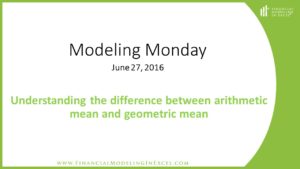Understanding the Difference Between Arithmetic Mean and Geometric Mean
 Often investors, analysts, and managers use the term “average” when discussing returns or potential growth rates. Unfortunately, there is can be a bit of vagueness with the term average. The biggest difference is whether arithmetic averages or geometric means are being discussed. Depending on the situation, there can be vast differences between these two terms their results.
Often investors, analysts, and managers use the term “average” when discussing returns or potential growth rates. Unfortunately, there is can be a bit of vagueness with the term average. The biggest difference is whether arithmetic averages or geometric means are being discussed. Depending on the situation, there can be vast differences between these two terms their results.
To begin, the term “average” is synonymous with “mean” and is used interchangeably. I myself use both terms.
Arithmetic Mean is defined as the average of a set of numerical values, calculated by adding them together and dividing by the number of terms in the set.
Geometric Mean is defined as the central number in a geometric progression, also calculable as the nth root of a product of numbers.
The difference between these calculations is the effect of compounding. Arithmetic mean does not take into account compounding, while geometric mean does. For this reason, arithmetic mean will likely overstate the compound returns or growth rates.
Arithmetic Mean
I demonstrate how to calculate arithmetic mean using the AVERAGE formula and standard deviation using the STDEVA formula. The STDEVA formula is not required to calculate the mean, but helps illustrate the difference between arithmetic mean and geometric mean.
Geometric Mean
To calculate the geometric mean, we will use the formulas PRODUCT and COUNTA. I also show an advanced array technique for calculating the geometric mean without having to use intermediate cells and formulas.
I hope you find this tutorial informative and entertaining.
Click Here for the tutorial
Happy Modeling.
